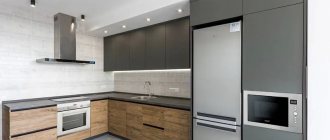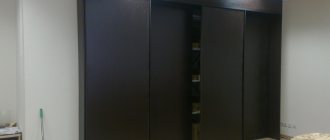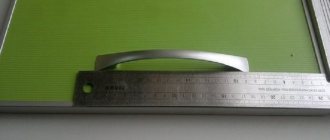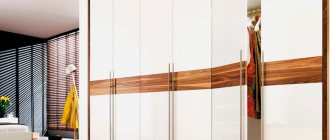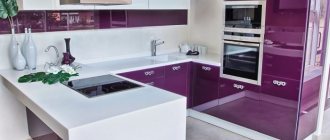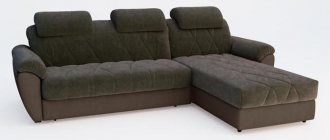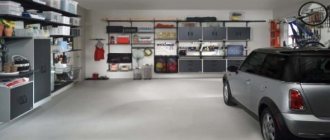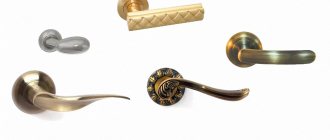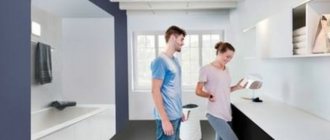Hello, dear friends! Today we are talking about facades without handles. This is a modern, as well as stylish and largely practical solution that can be used for kitchens, living rooms, hallways and other rooms with furniture.
Many people are accustomed to using the standard type of opening. These are accessories in the form of handles. You can buy them for little money and easily install them yourself.
Handles are relevant if it is an ordinary hinged cabinet, a facade with a dishwasher or washing machine, wall-mounted and floor-standing modules, etc.
But this is not the only option. Pens are not the only solution. And today you will see this. Let's look at the different options and see what their pros and cons are.
Main characteristics of furniture pushers, nuances of choice
Most stores that sell furniture fittings offer several types of pushers, stops, latches and other elements of pressure opening systems from different manufacturers. The price range may also vary, as may some technical specifications.
When choosing, pay attention to the following points:
- Pusher stroke. It can vary between 10-45 mm and is adjustable. If ordinary furniture hinges or hinges with closers are used (for smooth closing), then it is better to install pushers with a stroke of 40-45 mm on the facades. If you decide to use furniture hinges with return springs, then the stroke may be less, as in the case of springless hinges. But it is definitely better to choose magnetic pushers (that is, with a magnetic tip).
- Spring/gas lift force. There are standard and enhanced options. For heavy doors and large drawers, it is better to purchase reinforced pushers. Or put two on the façade (which is not always justified or acceptable).
- Mounting method, overhead or mortise . It all depends on personal preferences and installation nuances. For internal facades, of course, they purchase overhead pushers, since cutting into the end is impossible. To install mortise components, it is necessary to drill a hole in the end with a diameter of 10 mm and a depth corresponding to the length of the pusher capsule.
- Tip type. The pusher can be equipped with a magnetic tip to additionally hold the sash. Or rubber to ensure softer and quieter closing. Magnetic pushers are uniquely selected for return loops, as described above. And also to folding facades equipped with additional lifting mechanisms.
- Capsule color. As a rule, the range is limited to neutral white or gray tones. There are models on sale with capsules and adapters in black, beige, metallic or stainless steel.
Necessary accessories
Designing a kitchen without handles is not as easy as it seems. Of course, you can choose the easy option and simply make the door longer than the body, but this option is only suitable for a wall-mounted set. You will still have to come up with something with the bottom one.
The necessary fittings depend entirely on what type of “handle” in a handleless kitchen is chosen. For example, consider the elements of the “Push to Open” system:
- hidden hinges - springs are hidden inside them, which push the facade away from the body when pressed;
- push button - pushes the door, mounted in the cabinet frame.
To smoothly and quietly close the drawers, you will need other fittings:
- closers;
- dampers;
- shock absorbers.
There is a wide variety of even these elements on the market. Most often, there is no need to understand individual parts, since the necessary kit with all the necessary fasteners is purchased immediately. It is better to be familiar with popular brands that produce quality products for handleless kitchens.
Simple and inexpensive pusher with single and double magnets
Even before products from such brands as Hettich, Blum, Boyard, etc. appeared on the Russian market, furniture makers successfully used a simple magnetic pusher for glass doors. It can be purchased complete with a single or double magnet and special metal pads.
The mechanism is also suitable for installation on ordinary, solid cabinet doors. True, for the magnet to also “work”, you will have to either unbend and drill out the metal plates included in the kit, or adapt something else. An alternative is to glue or screw in a small round washer using a self-tapping screw.
Three reasons to make a cabinet without handles
Any design decision should be considered from a practicality point of view. Of course, facades without protruding handles look modern and stylish. And, as practice shows, they turn out to be quite convenient to use. We can highlight at least three undoubted advantages:
- Visually, facades without handles with a flat surface are perceived as a continuation of the walls. The absence of unnecessary details helps create the feeling of more space than it actually is. This effect is good to use in small kitchens.
- Also, the absence of protruding elements is valuable for narrow spaces. For example, in a narrow hallway where you can’t turn around, cabinets without handles will help you avoid uncomfortable moments: there will be nothing else to bump into or cling to.
- Corner kitchens without handles also guarantee that the surfaces of the facades adjacent to the corner will remain undamaged. Situations where, when opening, the handle “hits” the adjacent door are not uncommon, although this is considered a design error.
Magnetic pusher for Boyard cabinet door
Overhead magnetic pusher for cabinet doors in a stainless steel capsule. The magnet also plays a “holding” role and protects against sudden full opening of the sash. The manufacturer (Boyard) recommends using this type of magnetic pushers in combination with furniture return hinges.
Kitchen without handles: pros and cons
A kitchen with smooth fronts without handles is one of the trends in modern interiors. Furniture of this type is easy to fit into a design project in eco, minimalism, loft, and modern styles.
Read on the topic: Loft-style kitchen interior: design features
Other advantages of handleless fronts:
- They are convenient even in narrow passages and in the kitchen work area, where protruding handles make it difficult to move freely.
- The kitchen visually seems more spacious and lighter.
- They make it easy to maintain cleanliness: it is enough to occasionally wipe the smooth surface with special cleaning compounds. The presence of handles slows down cleaning because dirt usually accumulates around them.
- Ideal for corner modular kitchens where cabinet doors may touch each other when opened. If there are no metal handles, then the risk of damaging the facades is eliminated for any arrangement of cabinets.
There are also disadvantages, but they are few. Firstly, kitchen elements with closers or a push-open mechanism may periodically require repairs, because they are technically more complex than simple cabinets with handles. And secondly, the cost of furniture with smooth facades is usually higher than that of classic options. Before choosing a kitchen, it is important to weigh the pros and cons, but overall, this is a convenient option.
Hettich Push-to-open system
The Push-to-open series of systems for opening furniture facades by the famous German manufacturer Hettich provides absolutely all options for pusher pushers:
- Push to open Magnet. Standard magnetic pusher with self-adhesive striker included. Additionally, you can purchase an adapter for surface mounting and a strike plate with a coupling if the adhesive base is not acceptable for some reason. Recommended for use in combination with hinges of the same series. Designed for small doors, 300-600 mm wide and 300-900 mm high.
- Push to open Magnet XL . Unlike the previous version, the reinforced magnetic pusher is equipped with a stepless gap adjustment system (2.3-5.3 mm). Can be used for installation on doors 300-600 mm wide and 900-1600 mm high.
- Push to open Pin . An interesting model of the stop-latch “in reverse”, when the applied capsule is installed on the side of the body, and the pusher itself is mounted on the inside of the facade. Without magnet. Recommended for use in combination with Push to open hinges. Designed for a substantial weight of facades, 300-600 mm in width and up to 300-2400 mm in length.
- Push to open Universal maxi. A universal pusher without a magnet, which can be installed on facades with any furniture hinges.
Advantages and disadvantages
When choosing furniture handles, many people think about abandoning them altogether. Modern offers attract advanced people.
To begin with, in general terms, what are the strengths and weaknesses of facades without handles.
The advantages are as follows:
- facades remain cleaner and easier to maintain;
- nothing interferes;
- it is a safe and practical solution;
- good protection of children from access to dangerous objects;
- modern and stylish appearance;
- additional space saving.
But there is also a downside, because of which many continue to install plastic handles on furniture doors and drawers.
We are talking about such moments:
- Dirt accumulates on hidden systems, which is not so easy to clean;
- if some systems are accidentally touched, an opening will occur, although you do not need this;
- installation is usually more complex, but depends on the specific system;
- the impressive price still remains one of the main obstacles for most people.
Now we need to look at facades without handles, as well as ways to implement them.
Many people are attracted to the hidden mechanisms without pushing away with their hands, the need to apply force or grab a standard handle.
Tip-on Blum push release system
The Tip-on series from the Austrian manufacturer Blum offers two types of magnetic pushers:
- Standard. The stroke length of the magnetic pusher is 18 mm. For installation on small and medium sized doors (height up to 1300 mm)
- Long. The stroke length of the magnetic pusher is 38 mm. Reinforced option for larger doors and drawers.
The Blum Tip-on series magnetic pushers are available for surface-mounted and flush-mount installation (adapter for surface-mounted installation is sold separately). Recommended for installation complete with springless hinges.
Options for opening facades without handles
There are many mechanisms for opening kitchen facades without traditional handles, both in terms of operating principles and cost.
- profile;
- integrated;
- push-open;
- milled;
- with mini handles;
- with invisible handles;
- mortise handles;
- sensory.
Let's look at the most popular options.
Profile false handles gola
The Gola profile for facades has a groove in which the profile is positioned in such a way that it can be easily grabbed from the front and pulled towards you.
Gola profiles can also be equipped with LED lights - Gola Alphalux. The LED strip is installed in a groove in the profile and covered with a polycarbonate cover, which diffuses the light.
Advantages of Gola: practical, with light pads; they do not touch the surface of the door when opening, thereby maintaining a respectable appearance longer; Since the front panels do not have traditional front supports, there is no risk of damage to the neighbor's door, which is important for corner sets and radius facades with an integrated handle. Latch and profile options and related components: use and installation. Furniture sets in general, and kitchen furniture in particular, can consist of several front parts. Depending on whether the modules are placed at the top or bottom, different types of Gola profile handles and their equivalents are used. The profile handle, also known as the "top module" handle, is used in many sliding wardrobes. The model is recessed so that the front part can be easily grasped and opened with one hand.
Integrated profile mortise end handles
The only visual difference is that panels with integrated cable profiles have a thin frame at the top and longitudinal seams between adjacent boxes. Cable profile inserts are sold in 3-4 cm lengths and then cut to size. Cable profiles can be horizontal (for base cabinets and drawers) and vertical (for wall cabinets). Advantages: The main advantage of profile brackets is that they do not touch the end of the cabinet, so there is no mess when opening and closing the cabinet. At the same time, all the advantages of a profile without traps are retained; handles with an integrated profile are slightly cheaper than Gola profiles and push handles, as they do not require milling. Disadvantages: if the color of the profile handle for the kitchen facade does not match the color of the facade, it will be noticeable, which is not always desirable; The range of models of kitchen profiles without handles is very limited. The most common are aluminum profiles with a steel coating; profiles in black, white or chrome shades are less common.
Magnetic latches series Push Magnetic Makmart
The peculiarity of the Push Magnetic series is its modularity. You can only purchase a magnetic pusher with a metal self-adhesive overlay on the facade for insertion into the end of the body. If you require an overhead version of the pusher, then purchase an adapter with fastening with screws or an adhesive base. The metal striker with adhesive is convenient for installation on facades made of aluminum frames. There is a variant of the strike plate on the “nail”.
Styles
A kitchen without handles will not look appropriate in any interior. The best solutions are modern styles with a focus on minimalism. It can be modern, hi-tech, loft, Scandinavian or Japanese style.
All of these styles stand for convenience and functionality. This means that if you are not sure that such a kitchen is a convenient and practical solution, there is no need to make it. There are many other ways to decorate a room in a modern style.
Magnetic latches for opening by pressing the Push-latch series Makmart
The Push-Latch series includes all types of push mechanisms. With shock absorber (pusher stroke 40 mm) and magnet (pusher stroke 16 mm), with mortise and overlay installation, with appropriate fastening. There are several options for counter strips for the magnetic pusher, including under glass facades and aluminum frames.
General recommendations
- To make kitchen facades without handles less dirty from frequent touches, rely on light shades: white, beige, light gray, blue-gray, etc. Instead of a glossy finish, you should choose a semi-gloss, satin, matte or slightly rough finish.
- A black glossy kitchen without handles is the most impractical combination imaginable. It is suitable only for those who rarely cook and have assistants to clean the apartment.
- If you are not ready to give up handles completely, use them partially - best for lower cabinets and drawers, as they get dirty more than the upper ones. If there is a problem with a narrow passage, then, on the contrary, it is worth equipping the top row of the headset with handles.
Here are some photos of kitchens with upper cabinets without handles.
Modern kitchen design without handles
Kitchen with upper cabinets without handles
- You can also combine facades with different types of fittings. For example, wall cabinets can be opened using push mechanisms or extended fronts, and lower cabinets can be opened using the built-in Gola profile.
- Refusing handles on the facades, an exception can be made for the built-in refrigerator and dishwasher. Since more effort is required to open them, it is more convenient to open them by firmly grasping the handle.
How to properly install pushers for facades
Before installation, you should clarify which hinges the manufacturer recommends using to mount the facade itself.
- Some pushers require installation of the façade on springless hinges. In this case, the door is fixed in the closed state due to the magnetic tip and the metal striker.
- Furniture hinges with a return spring can “work” without a pusher at all. The ejection mechanism itself is already built into the hinge arm. The role of the latch stop itself is to soften the harshness of movement and fix the door.
- Some pushers allow the installation of furniture hinges with closers. This is a plus, since the ejection and soft closing mechanisms themselves are radically opposite and very rarely “get along” together.
The pusher capsule itself is installed in the place of intended pressing. For drawers - as close as possible. If the drawers are located one under the other, as in a chest of drawers, then it is better to provide special strips in the design of the box. Pressing on the sides of the front to push out the drawer is not always convenient.
Usually, the pusher comes with instructions with a detailed installation diagram for overhead and mortise installation.
Please note that the pusher itself can only operate if there is a gap between the facade and the furniture body. That is, the cabinet door or drawer should not be tightly adjacent to the box. Typically the gap is 2-3 mm. Four-hinged furniture hinges allow you to “pull out” the façade using an adjusting screw. But the drawer guides must be screwed in immediately, not as deeply as in the standard case (without any indentation from the edge).
The ability to adjust the length makes it easier to install the façade pushers. It allows you to set the optimal gap size by simply turning the pusher itself.
If the pusher has a length adjustment, you will not have to adjust the gap for the push mechanism to work correctly by adjusting the hinges and drawer guides. And installation is much easier.
The system for opening furniture facades by pressing is one of the ways to make doors without handles. You might be interested in learning how else you can make cabinets without handles.
Advantages and disadvantages
The decision to design a kitchen without handles causes a lot of controversy. Of course, the main factors that make people doubt are convenience and cleanliness.
The set without handles looks very beautiful, elegant and laconic. But will such a solution be functional? To understand whether this option is acceptable or not for a competitive kitchen or family, you need to weigh all the pros and cons of such a decision.
Advantages
Without a doubt, the main advantage is the appearance: the kitchen set looks like hello from the future. The kitchen is stylish, fashionable, attracts looks and compliments. But that's not the only reason to ditch pens.
Purity
Most often, your hands are not in a perfectly clean condition while cooking, and if you need to get something out or throw it away, you get a little confused in your head: how to do this with minimal “losses.”
It is much more convenient to open the lower cabinets with one push of the knee. This option is perfect for those cases where a trash can is hidden behind the lower facade and there is a need to throw something away without touching the headset with your hands.
Nothing gets in the way
Clothes often get caught on the handles, which is very inconvenient if you are holding, for example, a pot of boiling water - such “hooks” can lead to accidents.
Moreover, the handles are a problem for those who are used to listening to music on headphones while cooking: the wire will cling to the fittings, and the earbuds will fly out of the ears.
Safety
If there are small children in the family, then door handles are a toy for them that must be touched. This makes it easy to access pans, dishes, forks and knives in kitchen cabinets. Moreover, when small children play and run around, they may accidentally bump into a doorknob, resulting in scrapes and bruises.
It turns out that if you have small children, it is safer to make the kitchen without handles: they won’t climb inside and won’t bump into you.
Modernity
Yes, this solution is not suitable for all housewives. The absence of handles will not look good in every interior: only modern styles will do. But this is an ideal idea for those who keep up with the times and are used to supporting design trends.
Space saving
Handles are often abandoned in small kitchens, where literally every millimeter of space is important. This solution is especially popular in corner kitchens, when protruding handles make it impossible to open adjacent cabinets.
Flaws
The main thing housewives worry about is convenience. But convenience is more of a habit and too subjective, so it’s difficult to include it in the advantages and disadvantages. But there are real downsides to a handleless kitchen that are worth keeping in mind.
Dirt
Yes, dirt no longer settles on the handles, which are quite difficult to clean, but this does not mean that it disappears altogether. Glossy facades may attract fingerprints. On matte surfaces they are not so noticeable.
Dirt, and especially grease, can also accumulate in the recesses created for opening and closing drawers and cabinets without handles. The conclusion is that a kitchen without handles will not become less dirty, but it may be easier to clean.
Random touches
If we talk about the systems that are now fashionable, when the cabinet opens with one click, then the following difficulties may arise: if you accidentally touch the facade, for example, with your knee, the cabinet will open - this is, at least, inconvenient. At most, it can lead to injury.
Price
Yes, fittings make up a significant portion of the total cost of the kitchen. Moreover, if you abandon handles, not only will there be no savings, but the final price can only increase, since additional mechanisms and structures are required, which, due to their novelty, are not cheap. There are also inexpensive Chinese analogues - but who knows how long they will last?
Focusing specifically on these factors, it is necessary to decide whether the decision to abandon this fittings would be appropriate or not.
